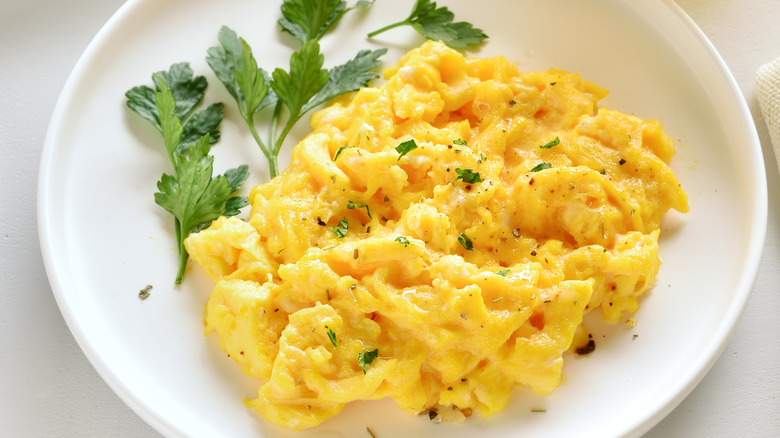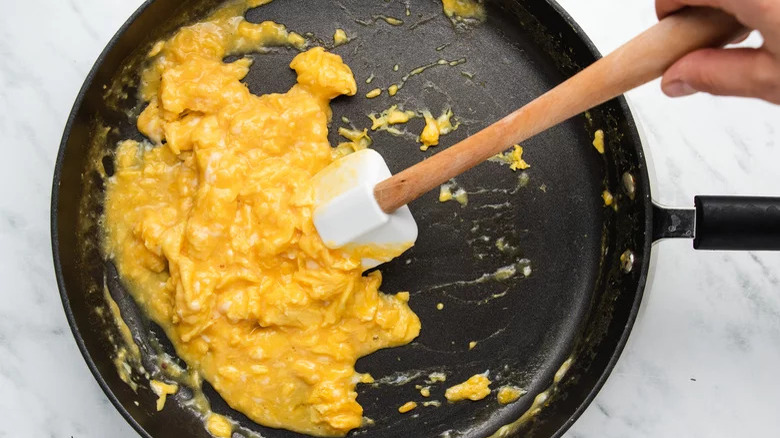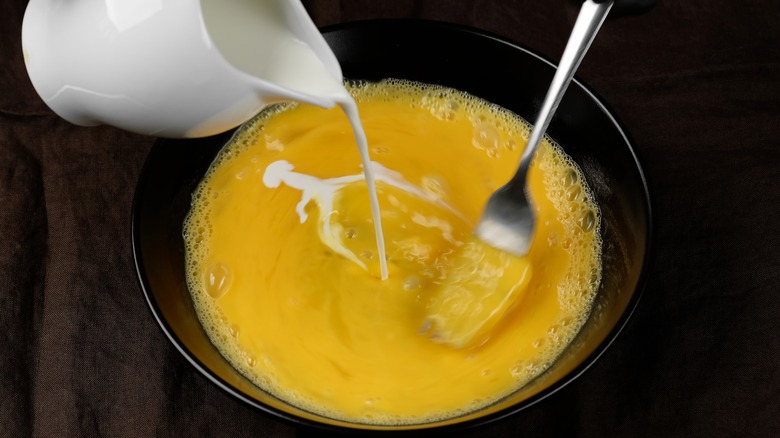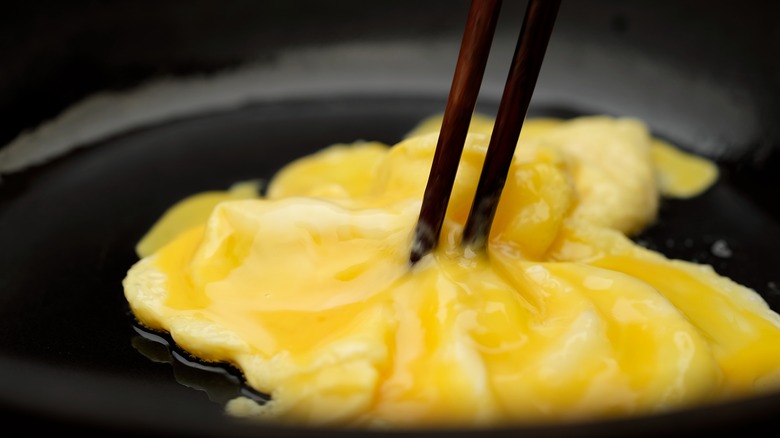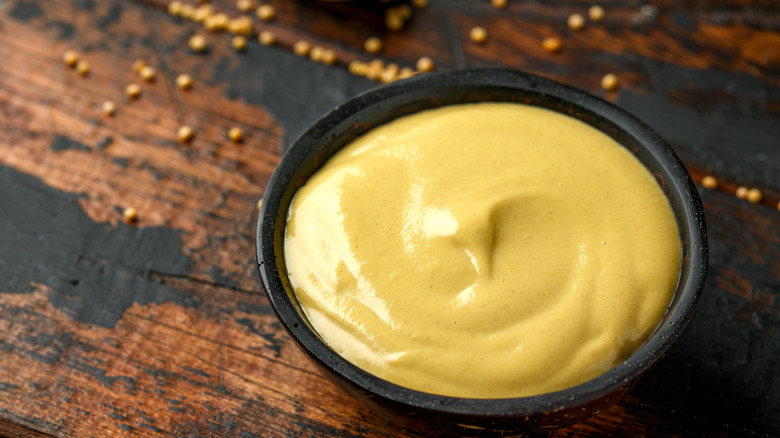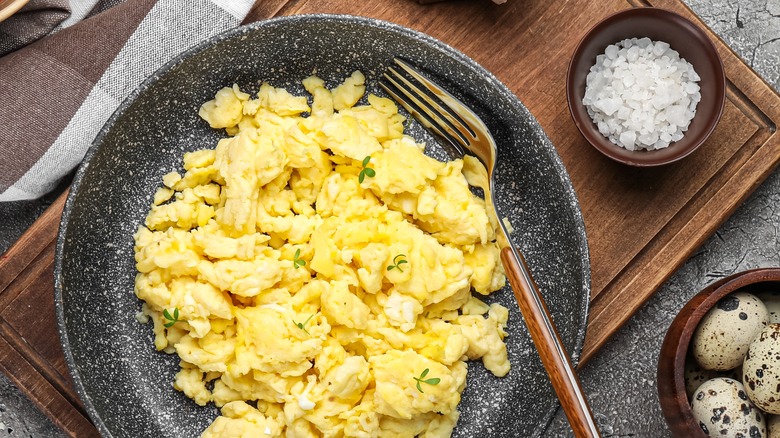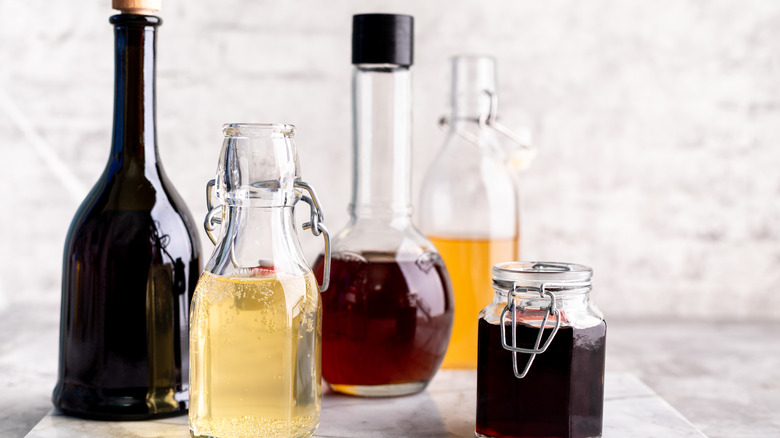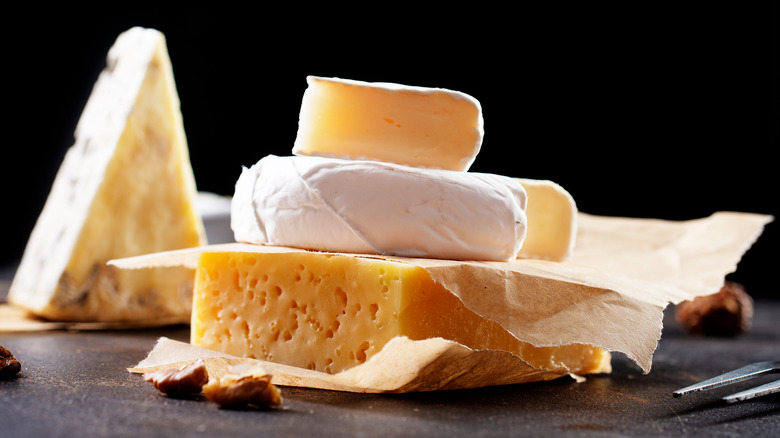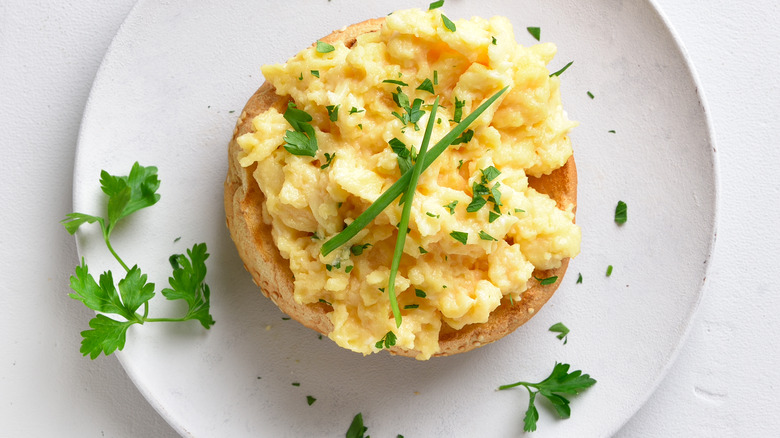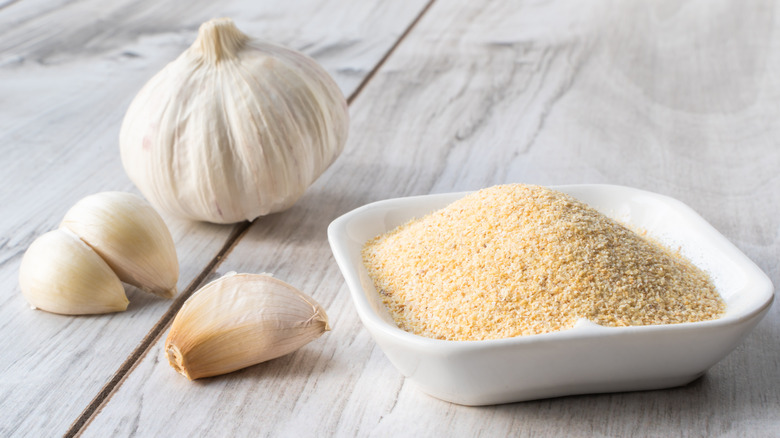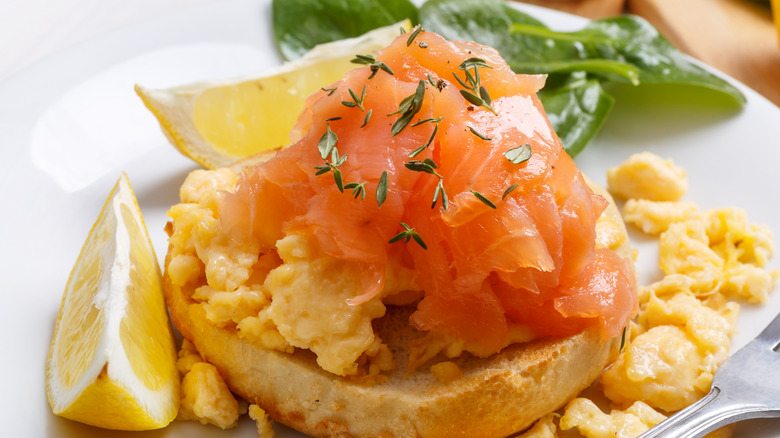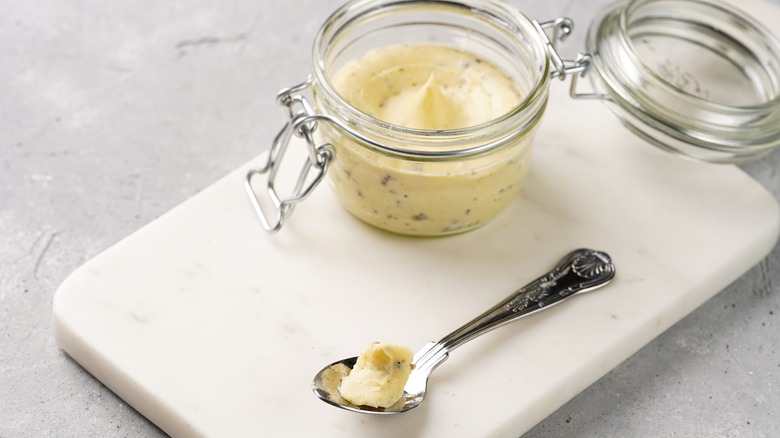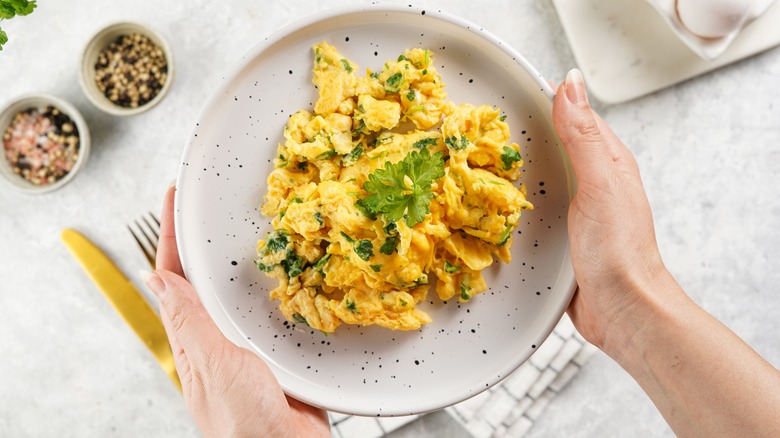12 Ways To Make Your Scrambled Eggs Taste Better
Scrambled Eggs are a beloved breakfast staple. They're easy to whip up, satisfying for both adults and children and can be made with ingredients you likely already have in your kitchen. A survey of Tasting Table's readers discovered that scrambled is the preferred method of egg preparation, beating out fried, omelet, and hard-boiled.
Since scrambled eggs are universally beloved, you might assume there isn't much variety in how they can be prepared, but you'd be surprised. How you like your eggs fundamentally changes how they should be cooked. Interested in eggs that are soft and creamy? Maybe you prefer your eggs light and fluffy. What about the size and consistency of your egg curds?
The good news is that scrambled eggs are simple to customize. This everyday dish can be instantly elevated by borrowing basic cooking tricks from renowned chefs and by incorporating surprising ingredients for enhanced flavor and a more decadent texture.
Cook your eggs slowly
Slow-cooking scrambled eggs is a time-honored technique that helps you achieve your desired scramble consistency without running the risk of your eggs drying out and losing moisture. Unlike using a slow cooker, which can be programmed to regulate temperature for a hands-off experience, slow-cooking eggs on the stovetop is all about being present in the kitchen.
To begin, set your burner to medium-low heat. This will prevent your pan from heating up too quickly. The hotter the pan, the quicker the eggs will cook and the less control you'll have over the final taste and texture. If you're using butter or oil, listen carefully. A hissing sound will let you know that your pan is hotter than it should be.
Carefully crack your eggs in a mixing bowl, stir to your liking, then pour the egg mixture into a heated pan and continue gently stirring. Once they're cooked halfway through, follow world-renowned French chef Jacques Pépin's trick for extra smooth scrambled eggs and remove your pan from the heat. Because of carryover cooking, your eggs will continue to cook even when taken off the stove. The residual heat from the pan and the heat retained by the eggs allow them to arrive naturally at a creamy finish.
Introduce cold ingredients midway through
While many recipes advise whisking together all your scramble ingredients before cooking, by withholding some of the cold components until the eggs have just begun to set, you'll immediately lower the temperature in the pan, allowing your eggs to scramble more gradually, helping you to achieve optimal creaminess. Gordon Ramsay's simple trick to prevent overcooking eggs is to wait to add the crème frâiche, heavy cream, or butter until your eggs are about halfway cooked.
As with most aspects of preparing scrambled eggs, crème frâiche, heavy cream, or butter is entirely a matter of taste. You can adjust the thickness and decadence of the scramble based on which ingredients you choose. While some cooks recommend milk or water, those liquids can have the effect of diluting the mixture, lessening its richness, and hardening the scramble.
For French-style scrambled eggs that have a soft, custardy texture, Jacques Pépin recommends reserving some uncooked egg alongside a portion of heavy cream to add to the pan midway through to slow down the speed of the cooking and to nuance the flavor of the scramble.
Use chopsticks instead of a whisk
While temperature regulation is an essential part of egg scrambling, what gives scrambled eggs its name is the process by which the eggs are continuously stirred in order to distinguish them from other preparations like an omelet or fried. Even if you're a scrambled egg master, this time before you reach for your whisk, instead consider picking up a pair of chopsticks.
Using chopsticks to scramble eggs rather than a fork, spoon, or whisk prevents them from developing too many air bubbles, which can leave your mixture tough and rubbery. Just as closely monitoring the pan's heat ensures you'll have more control of how quickly your scramble cooks, using chopsticks gives you greater agility to adjust the size of the curds to your liking. As the eggs break down on the stove, use your chopsticks to gently pull pieces of setting egg around the pan, moving continuously to achieve curds that are as large or as fine as your desired preference.
For the ultimate luxurious and flavorful scrambled eggs, add Dijon mustard
You may have already heard about adding crème fraîche, heavy cream, or butter to your scrambled eggs, but what about Dijon mustard? Mustard has long been overlooked in the kitchen because of its dismissal as an unrefined condiment, but don't let that deter you. There are many varieties of mustard and each can be a welcome addition to your cooking by enhancing flavors with a pleasing tang and varying degrees of spiciness. For scrambled eggs, we recommend using Dijon.
While yellow mustard is the type we often slather on grilled meats, Dijon is a versatile and stand-out ingredient in the kitchen that has the ability to alter not only the taste, but also the texture of a dish. Dijon is a French mustard made from black or brown mustard seeds and a combination of vinegar, white wine, water, and salt. Adding a spoonful of Dijon to your scramble elevates the flavor profile of your eggs by introducing a nice bite.
Because mustard is an emulsifying ingredient, it also serves as a thickening agent in your scramble, making your eggs heartier and creamier. Combine that with the sharp flavors of spice that Dijon elicits, and you've transformed everyday scrambled eggs into something special and decadent.
Wait to add salt until the end of the cooking process
One of the most common ingredients we utilize in the kitchen is salt. When added to a dish, salt amplifies the flavors it interacts with by intensifying sweetness and balancing against bitterness. But timing is everything. While many recipes call for salt to be added directly into the egg mixture before cooking, the scramble's silkiness will be disrupted if you salt your eggs too early. Not only will your eggs start to lose their freshness, they may also turn grey and watery. That won't be an issue if you follow Gordon Ramsay's trick for perfect scrambled eggs. Ramsay recommends waiting until the eggs are almost finished cooking before sprinkling in your desired amount of salt.
But what salt should you choose? While any salt will do in a pinch, there are a number of different salts you may have in your cabinet, and each has a different flavor and texture that can alter the taste of your scrambled eggs. Table salt is the finest of the main varieties, with kosher salt and sea salt increasing in coarseness and flavor intensity. For a flaky texture that adds depth and satisfies your taste buds, sprinkle flecks of sea salt over your eggs just before serving.
Top your scrambled eggs with an unexpected garnish
One of the joys of cooking scrambled eggs is its versatility. You can entirely change the flavor of the dish by topping it with a surprising finish. You've likely already heard of adding ketchup or hot sauce to your eggs, but what about something different? There are countless garnishes that pair well with scrambled eggs and the one you choose depends entirely on what direction you're inspired to take the classic in.
For a taste of umami, try drizzling your scrambled eggs with soy sauce. Similar to using salt, soy sauce heightens the savory intensity of the eggs while also deepening their flavor. What makes soy sauce excellent beyond its pleasing sharpness is that unlike salt, soy sauce distributes evenly into your scramble, preventing your eggs from weeping. Observing a gluten-free diet? Tamari is a wonderful soy sauce substitute that achieves umami richness and a darker and deeper flavor.
Interested in a tangy Italian twist? If you're looking for something decadent, consider Massimo Bottura's tangy addition for elevated scrambled eggs: balsamic vinegar. If you have a younger bottle of balsamic vinegar in your pantry, the consistency will be thinner and you can use this similarly as you would soy sauce. An aged bottle of balsamic is much thicker and has a more intense flavor. Bottura suggests drizzling high-quality balsamic vinegar on top of your egg scramble to give it a little something extra.
Incorporate cheese into your scramble
Cheese is a welcome addition to almost any savory dish. It adds saltiness, creaminess, and a sense of indulgence. When paired with scrambled eggs, cheese has a way of conjuring nostalgia, creating a sense of comfort that turns a simple breakfast into a transporting experience.
But the kind of cheese you use matters. If you'd like your cheese to be fully incorporated into your egg scramble, shred a hard or semi-hard cheese like sharp cheddar, Gruyère, or Manchego, depending on your desired flavor profile. Add the shredded cheese just before you remove the eggs from the pan, stirring constantly to achieve the right texture.
If you prefer gooey, partially melted cheese in your scramble, add chunks of mozzarella, feta, or goat cheese about halfway through the cooking process. This technique will allow the cheese to start melting into the eggs, leaving you with a satisfying scramble that is equal parts cheese curds, equal parts egg curds.
For a simpler and more classic approach, add your cheese as a topping once your scramble is finished cooking. We recommend grating Parmigiano Reggiano onto your eggs after plating them or adding torn pieces of sliced American cheese a few seconds earlier. The residual heat from the eggs will begin the melting process without overdoing it.
Fresh herbs easily elevate flavor
Fresh herbs are a subtle, yet impactful way to enhance the flavor of your egg scramble with minimal effort. There are countless herbs to choose from and each can help distinguish your scramble by altering the taste and making a straightforward dish feel surprising and elegant.
So, which herbs should you choose? The simplest answer is whichever herbs you have on hand, but if you have some prep time, consider how the following herbs can dramatically elevate your egg scramble.
French Tarragon is a favorite among many chefs because of its complex flavor profile. Hints of licorice create a gentle spiciness that's followed by a citrus finish.
Chives are the herb of choice for Gordon Ramsay's scrambled eggs. Ramsay sprinkles a hearty portion of snipped chives on top of his egg scramble just before serving. Chives are a powerhouse ingredient because they embody the flavors of onion and garlic without the fuss and lengthy preparation.
Dill is most often thought of as an herb for seafood, but we recommend also trying it on your egg scramble. Dill packs a flavorful punch with notes of grass and citrus while simultaneously conjuring a subtle sweetness. Your eggs will take on a completely new dimension when topped with dill.
If you're in a pinch, dried herbs will do as a substitute for any of these, but for the full effect, we recommend using fresh. Remember to always wash your fresh herbs before adding them to your dish.
Reach for your favorite spices
Spices are a secret weapon in the kitchen. Like fresh herbs, they're a simple way to instantly enhance your egg scramble with little extra work. Spices differentiate themselves from fresh herbs by providing an even more intense flavor that can be customized based on what you happen to have in your cupboard. Many of us instinctively reach for salt and pepper when we're looking to add depth to a dish, but there are more nuanced spices that can add even more dimension to your scramble just as easily. For scrambled eggs, our go-to spices are garlic powder, onion powder, cayenne, and curry powder.
All four of our recommended spices have savory notes that will make your egg scramble more satisfying and more flavorful. The amount of spice you add to your scramble is completely up to you and the spices can be used in combination with each other. Curry powder and cayenne bring lots of heat, so those two should be added more gradually to ensure the spice level is to your liking.
Add a nutritious centerpiece
Looking to make your scramble even more nutritious? Or maybe you're interested in adding a wow factor to the breakfast table? Try pairing your scrambled eggs with a luxurious centerpiece to help them transition from a simple breakfast dish into a substantial brunch, lunch, or even an unconventional dinner standout.
On their own, eggs are packed with protein, but you can make them even heartier by adding another protein source that not only amps up the nutritional value, but also introduces vibrant, unexpected flavors.
A tried and true addition to scrambled eggs is smoked salmon. ABC's The Taste winner Gabe Kennedy makes his egg scramble with pieces of smoky soft salmon. Because smoked salmon is delicate, wait to add your desired quantity until your eggs are removed from the heat to prevent the fish from drying out.
Prosciutto is a staple in Italian cooking. The slow-cured pork is satisfyingly salty and delicately sweet. Add slices of prosciutto either as is or torn into small pieces on top of your egg scramble after plating it.
For a savory vegetarian feast that requires a little more effort, but makes up for it with a mouthwatering umami flavor, sauté mushrooms in a pan with butter or oil. Before adding to your scramble, ensure the mushrooms have sweated out their moisture and begun the process of caramelizing. Scramble your eggs separately, then top them with the caramelized mushrooms before serving.
Go the extra mile with cold truffle butter
Butter might not sound like a revolutionary addition to your egg scramble, but what about truffle butter? Truffle butter is a gourmet variation of butter that's made with fresh truffles, truffle oil, or a combination of the two. Truffle butter adds the creaminess you've come to expect when cooking with butter while also introducing the complex flavor of truffle into the dish. The taste of truffle is almost as strong as its scent, which is an intoxicating blend of nuttiness and earthiness.
The Barefoot Contessa star Ina Garten uses cold truffle butter when making her scrambled eggs for similar reasons to Jacques Pépin and Gordon Ramsay, but her technique is unique. Instead of adding the butter midway through the cooking process, Garten waits until her scramble is just about to reach its desired consistency before she adds two knobs of cold truffle butter into the pan. The cold truffle butter prevents the eggs from cooking any further and the truffle flavor brings in the intensity of umami, becoming a finishing touch that revamps an otherwise basic scramble into a dish that's refined and indulgent.
Serve on a heated plate
Many cooks believe that the way food is served can be just as important as the way it's prepared. So, how should you serve your scrambled eggs? Chef Alton Brown and Martha Stewart both strongly advocate for serving scrambled eggs on a heated plate. Transferring your scrambled eggs to a heated plate ensures your eggs won't dry out or turn cold before you've begun eating. Additionally, the warmth from the dish allows you to remove your scramble from the pan before it's finished cooking without having to worry about your eggs being underdone. According to Alton Brown, your scrambled eggs will arrive at the right consistency while on the heated plate so that you can focus on enjoying your meal.
Don't have an electric plate warmer? Not a problem. There are several simple options for preheating your plate depending on your dishware and your allotted prep time. You can pop your plate in the microwave, put an oven-safe plate in the oven set to very low heat, or you can run your plate under hot water. Each technique is fairly straightforward and leaves you with a warm plate to serve your scrambled eggs on for the perfect texture and temperature.
Static Media owns and operates Tasting Table and Mashed.
